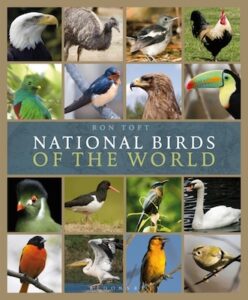You likely already knew that the national bird of the United States is the American Bald Eagle, and – if you know a bit about birds – you could probably have guessed that the national bird of Guatemala is the Resplendent Quetzal, but what is the national bird of Estonia? How about Israel? Jamaica? If you don’t know, don’t feel bad; I didn’t either – at least until I read Ron Toft’s new book National Birds of the World.
After an official flag, a national bird is a remarkably common symbol of a sovereign people’s identity. Nearly one hundred nations, as well as a few territories and protectorates, as well as dozens of states and provinces, have a designated an official bird – Trinidad and Tobago even has two. They are chosen for a variety of reasons. Some are symbolic of how the people of the nation (or at least those who have a say in the governance of them) either view themselves, such as Benjamin Franklin’s suggested Wild Turkey for the then infant United States of America, or portray what they see as an important aspect of their identity to the rest of the world, such as in the American Bald Eagle that was chosen for it instead. Others are chosen because of particular species being endemic or of great importance to wildlife conservation – the Resplendent Quetzal of Guatemala, for example. Still others, such as the Indian Peafowl of India, are symbolic of an important aspect of a nation’s culture or religious identity.
However for whatever reason or reasons a bird may have been originally chosen, how it lives – in its physical presence, in imagery, or in the social traditions of the nation (such as the Saker Falcon in Mongolia’s age-old practice of falconry) – is the real heart of the stories told in National Birds of the World. Each of the ninety-nine species included by the author is not only photographically depicted, and its IUCN status and life history information explained, but a wide variety of information about its “cultural presence” is provided. How were Kiwis seen and used by the Maori? Why do some Japanese consider the Red-crowned Crane to be Japan’s national bird rather than the officially designated Green Pheasant? And what does it say about Canada that its provinces each have an official bird but the nation itself does not? These are the types questions that make Mr. Toft’s book such an interesting one not only to read but to return to again and again as a valuable reference source.
Mr. Toft, a freelance wildlife journalist and photographer, whose professional biography includes the editing of the “It’s A Wild World” nature pages on TheTravelEditor.com website, and frequent contributions to such periodicals as Cage & Aviary Birds, Travel Zambia, Good Motoring, The Countryman, Veterinary Times and numerous airline and ferry titles, possesses just the right combination of expertise about his subject as well as extensive experience in writing about it for a wide-ranging audience. As a result, National Birds of the World is a very accessible book, suitable for children as well as adults. And with such a wealth of material about the birds themselves as well as the cultures of the nations they have been selected to represent, it will likely be as interesting to the traveler (both arm-chair as well as international) or geography buff as it is to the amateur nature enthusiast or ardent twitcher.
So whether or not you knew that the Barn Swallow was the national bird of Estonia, the Eurasian Hoopoe that of Israel, or the Red-billed Streamertail of Jamaica, if you have any interest in birds, geography, the world’s many varied and fascinating cultures, or simply reading books that provide copious occasions to exclaim “I didn’t know that!” then Ron Toft’s National Birds of the World is a book you should most certainly add to your library – and perhaps consider adding to a friend’s as well.
 Title: National Birds of the World
Title: National Birds of the World
Author: Ron Toft
Publisher: Bloomsbury
Imprint: Bloomsbury Natural History
Published: 16 December 2014
Format: Hardback
Pages: 224 pp. with 550 color images
ISBN: 9781408178355
In accordance with Federal Trade Commission 16 CFR Part 255, it is disclosed that the copy of the book read in order to produce this review was provided gratis to the reviewer by the publisher.
